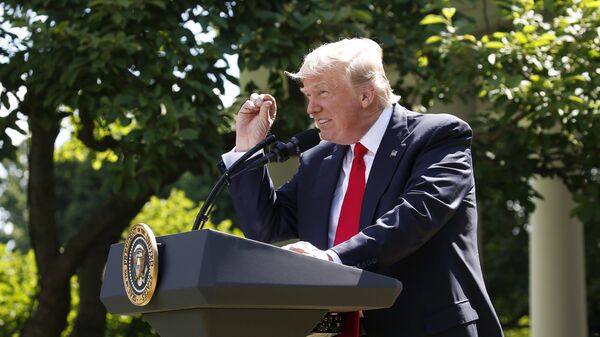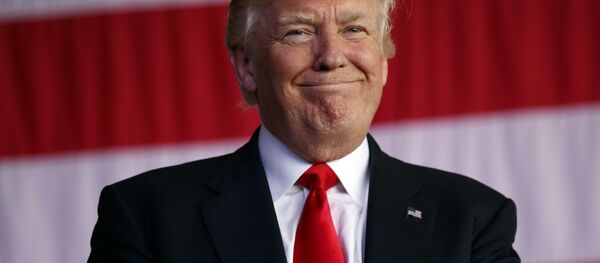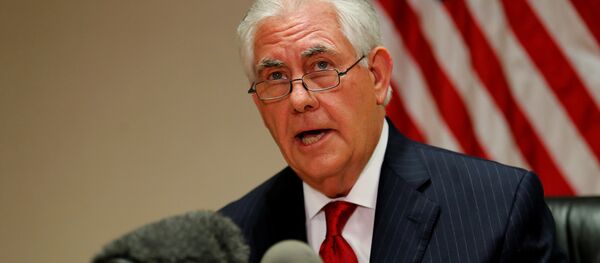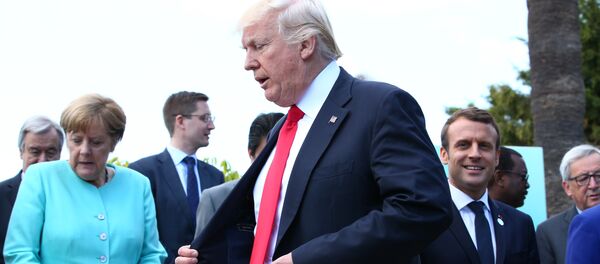MOSCOW (Sputnik) — By withdrawing from the Paris Accord and continuing to roll back environmental regulations introduced under the Obama administration, US President Donald Trump found the easiest campaign promise to fulfill as he tried to please the supporters who voted him into office, experts told Sputnik.
NO CONGRESSIONAL APPROVAL NEEDED
Trump officially announced his decision to exit the Paris Accord on Thursday, claiming the multinational agreement on climate would undermine the US economy, hamstring US workers, weaken US sovereignty, impose unacceptable legal risks, and put the United States at a permanent disadvantage to other countries of the world.
"It is time to put Youngstown, Ohio, Detroit, Michigan, and Pittsburgh, Pennsylvania — along with many, many other locations within our great country — before Paris, France," Trump told reporters in a ceremony at the White House Rose Garden.
After struggling to keep a number of promises he made during his 2016 US presidential election campaign, such as immigration and healthcare reforms, Trump looked to be keen on making good on his campaign promises to undo his predecessor’s climate change agenda.
Compared to immigration and healthcare reforms, which usually require a long legal process and approval from the US congress, Trump could easily reverse environmental regulations and commitments introduced by the Obama administration, analysts said.
"Trump is very skeptical about climate change. He is trying to undo everything Obama did. He could do it through executive orders, without any congressional actions," James Van Nostrand, a law professor at West Virginia University and the Director of the school's Center for Energy and Sustainable Development, said.
The Paris Accord entered into force on November 4, 2016 and countries cannot withdraw until three years have elapsed from when the Accord went into effect. This means the United States would have to stay part of the agreement until November 2019. After that, the rules mandate a one-year notice period, which would mean a withdrawal in late 2020 — after the next US presidential election on November 3, 2020.
CARBON INTENSIVE AMERICA
With executives from coal mining companies and miners standing behind him, Trump introduced his long-promised executive order in late March to abolish President Obama’s climate change efforts and revive the nation’s coal industry. Similar to numerous rallies during his presidential campaign, Trump promised to send the miners back to work.
Trump’s victory in the 2016 US presidential election came largely thanks to support from the white working class in rural areas of the US, especially states in central and mid-west regions. Those states, led by Wyoming, West Virginia, North Dakota, Louisiana and Montana, are the regions with the highest carbon intensity in the United States, according to data from the US Energy Information Administration (EIA).
In her book titled The Politics of Resentment, Katherine Cramer, a political science professor at the University of Wisconsin–Madison, tried to investigate the reasons behind Trump’s triumph through an often-overlooked piece of the puzzle in the US presidential election: rural political consciousness and the resentment of the "liberal elite." Rural voters are distrustful that politicians will respect the distinct values of their communities and to allocate a fair share of resources to them.
Trump’s promise to create jobs for working class US nationals such as coal miners, or at least help them to keep their current jobs, helped him pull off an improbable victory over Hillary Clinton last year. Despite steep competition from other energy resources such as natural gas putting a great deal of pressure on the US coal industry, Trump continued to try to fulfill his campaign promise by reversing environmental regulations that are unfavorable to coal, which is a dirtier fossil fuel than natural gas.
Figures from the US EIA showed that in 2016, the electric power sector accounted for an estimated 92 percent of total US coal consumption. From 2008 to 2016, coal’s share of electricity generation decreased, and in 2016, natural gas-fueled generation exceeded coal’s share of US electricity sources on an annual basis for the first time. But coal’s share of US electricity generation still stood at 30.4 percent in 2016, while wind and solar contributed merely 5.6 percent and 0.9 percent, respectively, during the same period. About 65 percent of US electricity generation in 2016 came from fossil fuel.
But experts suggest that the demise of the coal industry in the US is irreversible because of the trends of market forces.
"Although coal is still expected to contribute to 25-30 percent of electricity generation in the next 20 years in the US, no new coal plant is being built. Nobody is moving into that industry," Professor Van Nostrand emphasized.
"Political leaders in Pittsburgh (Pennsylvania) did a good job 20-30 years ago transforming away from the steel industry. The political leadership needs to help West Virginia and Wyoming transition into the next great thing," Van Nostrand said.
As Trump takes a series of actions to undo the environmental regulations introduced by the Obama administration, it is unlikely for the United States to meet the target of reducing 26-28 percent in greenhouse gas emissions by 2025 from 2005 levels, the Rhodium Group, which has provided an independent annual assessment of US greenhouse gas emissions since 2014, said.
According to the group’s latest research report in May, under current policy, the United States is still set to come within striking distance of its Copenhagen target of a 17-percent reduction below 2005 levels by 2020. But absent any new policy, the United States is only on course for a 15-19 percent reduction in greenhouse gas emissions by 2025.







